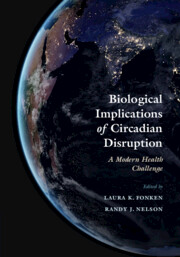Book contents
- Biological Implications of Circadian Disruption
- Biological Implications of Circadian Disruption
- Copyright page
- Contents
- Contributors
- Preface
- 1 Introduction to Circadian Rhythms
- 2 Central Clock Dynamics
- 3 Melatonin, Light, and the Circadian System
- 4 Disrupted Circadian Rhythms, Stress, and Allostatic Load
- 5 Disrupted Circadian Rhythms and Mental Health
- 6 Circadian Rhythms and Cognitive Functioning
- 7 Circadian Rhythm Disruption in Aging and Alzheimer’s Disease
- 8 Circadian Rhythms Regulate Neuroinflammation after Traumatic Brain Injury and Spinal Cord Injury
- 9 Disrupted Circadian Rhythms and Neuroendocrine Function in Fertility
- 10 Disrupted Circadian Rhythms and Metabolic Function
- 11 Disrupted Circadian Rhythms, Time Restricted Feeding, and Blood Pressure Regulation
- 12 Disrupted Circadian Rhythms and Immune Function
- 13 Circadian Rhythms and Cardiac Function
- 14 Disrupted Circadian Rhythms and Cancer
- 15 Light Effects across Species in Nature
- 16 Measurement and Analysis of Exposure to Light at Night in Epidemiology
- Index
- References
8 - Circadian Rhythms Regulate Neuroinflammation after Traumatic Brain Injury and Spinal Cord Injury
Published online by Cambridge University Press: 07 October 2023
- Biological Implications of Circadian Disruption
- Biological Implications of Circadian Disruption
- Copyright page
- Contents
- Contributors
- Preface
- 1 Introduction to Circadian Rhythms
- 2 Central Clock Dynamics
- 3 Melatonin, Light, and the Circadian System
- 4 Disrupted Circadian Rhythms, Stress, and Allostatic Load
- 5 Disrupted Circadian Rhythms and Mental Health
- 6 Circadian Rhythms and Cognitive Functioning
- 7 Circadian Rhythm Disruption in Aging and Alzheimer’s Disease
- 8 Circadian Rhythms Regulate Neuroinflammation after Traumatic Brain Injury and Spinal Cord Injury
- 9 Disrupted Circadian Rhythms and Neuroendocrine Function in Fertility
- 10 Disrupted Circadian Rhythms and Metabolic Function
- 11 Disrupted Circadian Rhythms, Time Restricted Feeding, and Blood Pressure Regulation
- 12 Disrupted Circadian Rhythms and Immune Function
- 13 Circadian Rhythms and Cardiac Function
- 14 Disrupted Circadian Rhythms and Cancer
- 15 Light Effects across Species in Nature
- 16 Measurement and Analysis of Exposure to Light at Night in Epidemiology
- Index
- References
Summary
The circadian system in mammals involves a hierarchy of clock regulators that entrain circadian rhythms in the periphery. The molecular circadian clock regulates all systems in the body, including the nervous and immune systems. Under healthy conditions, the circadian system enables effective function of the nervous and immune systems by promoting system vigilance during predicted daily active phases, and rejuvenation during rest phases. However, injury to the nervous system causes spiralling neuroimmune activation that exacerbates damage. Here, we will discuss how the circadian system regulates neuroinflammatory dynamics in the central nervous system during health and after neurotrauma. Traumatic brain injury or spinal cord injury dysregulate the circadian system, and circadian disruption is worsened during acute post-injury times by a suboptimal circadian environment in the hospital. In turn, circadian disruption unleashes immune activation and impairs reparative responses, thereby worsening damage. Given the intimate link between the circadian and neuroimmune systems, there are several levels of potential therapeutic intervention. Environmental interventions include improving light–dark amplitude between day and night and reducing nighttime interruptions acutely after neurotrauma. Pharmacologic interventions after injury could reinforce circadian rhythms or target clock genes to create a reparative neuroimmune milieu. Future studies should explore the circadian–neuroimmune axis, with a goal to use evidence-based chronotherapies to enhance repair and recovery after traumatic brain injury and spinal cord injury.
- Type
- Chapter
- Information
- Biological Implications of Circadian DisruptionA Modern Health Challenge, pp. 183 - 205Publisher: Cambridge University PressPrint publication year: 2023

